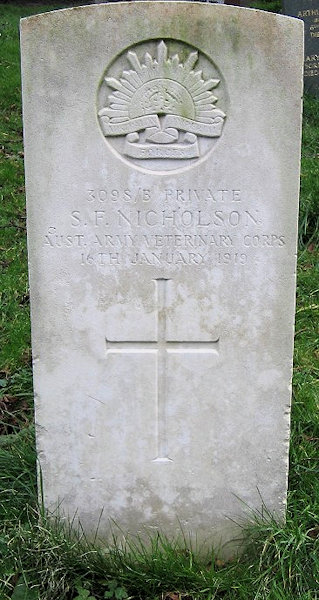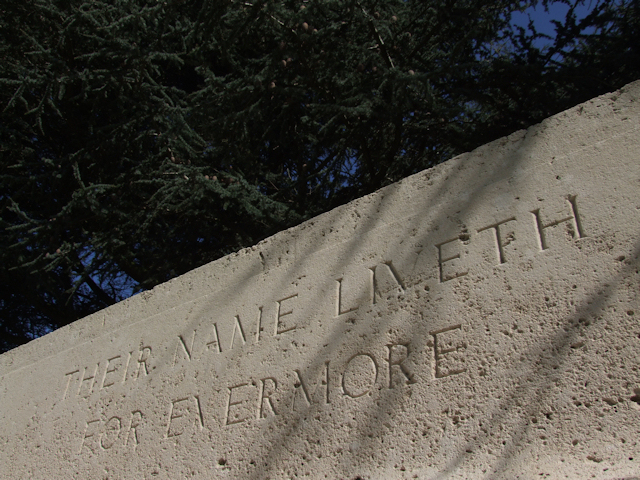Name
Stanley Frank Nicholson
Conflict
First World War
Date of Death / Age
16/01/1919
Rank, Service Number & Service Details
Private
3098/B
Australian Army Veterinary Corps
Vet. Hosp.
Awards: Service Medals/Honour Awards
Not Yet Researched
Cemetery/Memorial: Name/Reference/Country
STANDON (ST. MARY) CHURCHYARD
United Kingdom
Headstone Inscription
Not Researched
UK & Other Memorials
Standon War Memorial,
St Mary’s Church Memorial, Standon,
Puckeridge Village Memorial
Biography
Stanley Frank Nicholson (proper middle name) was a Private, No. 3098/B with the Australian Army Veterinary Corps when he died 16th January 1919. Stanley is buried in St Mary’s churchyard. He has a Commonwealth War Graves headstone.
The Standon burial register entry says that he was buried 23rd January 1919, age 21 years and that he died at St Michael’s Hospital, Birchington, Kent.
Parents, Frank Nicholson, an electrician, and Minnie Gertrude (nee Mather) were both born in Manchester.
The family came to London after the birth of their first son, William in 1895, the other children Stanley, Leslie and Lucy being born in London. All the children except Leslie were baptised in 1903 on the same day in St Jude’s, Grays Inn Rd, Holborn. We do not know what brought them to Standon, but at some point between the group baptism and 1908, father Frank dies, and Minnie re-marries, a farmer, Frederick Wilson Davis and in 1911 they are living in Wellpond Green Standon. Minnie lost her second husband in May 1913, but the boys did not stay around long, and in 1914, William departed for Australia followed in January 1915 by Stanley, aged 17 with Leslie, only 14 years old. When the war started, both older brothers enlisted when they could, William leaving Australia in November 1916, followed by Stanley in January 1917. William was wounded in action in October 1917 and spent some months in hospitals and convalescence homes in England, but recovered sufficiently to be sent back to France. He also married while he was in England. Meanwhile, Stanley was wounded 22nd August 1918 and although he seemingly recovered, there was a decline in his health from then on.
The following article from the Herts & Essex Observer dated 2nd February 1919 tells most of Stanley’s story:
"Military Funeral of Pte. Stanley Frank Nicholson – Pte. Stanley Frank Nicholson, second son by her first marriage of Mrs Davis of Oaklands, Well Pond Green, Standon, emigrated with his younger brother, Mr Leslie Nicholson, early in 1914 to join their elder brother in Australia. For a time they were engaged in sheep farming near Maitland, N.S.W. Pte Stanley Nicholson joined the 30th Batt. A.I.F. in 1917 and in August of the same year went to France. He was a gallant, courageous soldier of sterling character and formed one of that heroic band of Australians known as ‘Carmichael’s Thousand’ that fought so pluckily against overwhelming odds on Anzac Day, April 25th of last year, at Villers Bretna. He was badly gassed and wounded in the arm and side and one of the few survivors. Eventually he partially recovered and, after a short leave at home, in October last returned to France. He had, however, a recurrence of his severe illness, he was invalided to England and passed away at St Michael’s Hospital, Birchington, on the 16th ult, at the early age of 21. His remains were removed to his home in Standon on the following Saturday. The funeral took place with full military honours at Standon churchyard on the 23rd ult. The coffin, enfolded in the Australian flag, was conveyed from Well Pond Green in a Washington car. Sergt. Mercer and twenty soldiers from the A.I.F. HQ Horseferry Road, Westminster, came down to attend the funeral. Seven soldiers acted as the bearer party, and the firing party, consisting of twelve soldiers under Sergt. Mercer, marched in front of the funeral car and formed a guard of honour as the procession entered the church. The immediate mourners were Mrs Davis (mother), Signaller W.R. Nicholson, A.I.F., who had come from France to attend the funeral (brother), Mrs W.G. Dyer and Mr D.H. Deacon. There was a large attendance of parishioners, including many soldiers, anxious to pay a reverent tribute to the memory of the brave young soldier. The service, which was most impressive, was conducted by the Vicar, the Rev. R.B. Little. As the cortege left the church the organist, Mrs Hemingway, played the Dead March in “Saul”. The firing party with arms reversed stood near the grave-side while the committal portion of the service was read and at the close fired three volleys over the grave and then at the word of command fixed bayonets and presented arms while Bugler Corporal B. Molineau sounded the “Last Post”. The deceased was buried in the grave where rest the remains of his step-father. Wreaths with deep sympathy were sent from the Commandant, staff and patients of Quex Park Military Hospital, Birchington, and also from St Michael’s Hospital, Birchington, and among others was one from his mother, sister and brothers. Following their usual custom the Australians brought a wooden cross painted white, the deceased’s number, name, rank and date of death upon it, to be erected at the head of the grave."
A few words of explanation are perhaps necessary as a result of information in this article:
- A.I.F. stands for Australian Imperial Force
- Villers Bretna would seem to be the English version of the French town, Villers-Brettonneux (near Amiens).
- Having accessed the Australian Army records, it seems that Stanley was initially in the 35th Battalion, then the 36th, then the 33rd (when the 36th had been disbanded due to losses and the surviving men transferred to other Battalions).
- It may be that his last position in the Veterinary Corps may have been seen as a place to employ a man who was not completely fit.
The Australian Army records, which are extensive and very well kept, give much detail about Stanley and it seems that although he was wounded, the records only show a gunshot wound to an arm, with no mention of being gassed, but of course we will probably never know the complete truth. The records show that he had appendicitis in November 1918, followed by Acute and then Chronic Nephritis, from which he died.
A poignant end to this story is that Stanley’s younger sister Lucy also died in 1919 aged 15, and was buried just over six weeks after Stanley, just one other name separates the brother and sister in the burial register.
Acknowledgments
Di Vanderson, Jonty Wild



